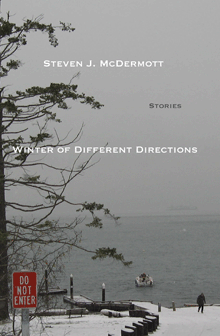12 Hot Stories Redux
Be sure to checkout the audio blog that accompanies this post: Listen to the mp3 (7:25 mins, 5.1 mb) or grab the RSS feed.
First, a nod, high fives, and big ups to some fellow bloggers who are promoting short stories this month in their blogs. The awesome Dan Wickett, founder and major domo of the Emerging Writer's Network, who's declared May short story month. Dan is aiming to promote at least two stories/collections a day.
Strength bro, much strength, to you in that mission!
Also joining Dan in short story month are Jeff Bryant and Cliff Garstang. Jeff's blog is Syntax of Things and Cliff's is Perpetual Folly. I'm excited to see the stories and collections that Dan, Jeff, and Cliff choose to showcase in their blogs. Check them out—you won't be disappointed.
Of course, here at Storyglossia, every month is short story month . . .
If you haven't taken a look at STORYGLOSSIA Issue 19, which was released on April 22nd, what are you waiting for?
I posted these notes on the issue's stories last week, but now I've recorded them for the audio blog, so here once again is the scoop on why I selected the stories in Issue 19.
Stephanie Dickinson's "First Love West Side Highway" drew me in with its dense descriptive texture and sensory language; plus the dual characterization/POV was spot on and juiced the tension in the storyline. This is a dangerous story and you'll be holding your breath in places.
James A. W Shaw's "The Clown Beneath" is a fantastic rendering of man plummeting toward the bottom. Also has its dangerous moments, as if you are blowing up a balloon and watching it stretch and stretch . . .
Jill Stegman's "Touch" reminds us that the aftereffects of war— in this case Vietnam—linger long after the war is over. It's the coping mechanisms in this one that elevate the danger. How does one dissolve old wounds when they still hurt?
Darby Harn's "Keeping Up Disappearances" is exactly the kind of story I hoped to see when I put out the request for more stories experimenting with form. It starts with a transcript from a TV show and where it goes from there you'll have to read on to find out.
Patricia DeLois' "Penguins in Amsterdam" continues her exploration of Sophie, the character we met in "The Venus Game" from Issue 17. This story is adapted from the opening chapters of her novel and hooked me right from the opening scene —notice how character and plot converge— and the ending left me wanting more . . . if you like this one, let me know and I'll persuade Patricia to give us another excerpt for a future issue.
Shellie Zacharia's "Vibe" is a sweet bit of metafiction. It's subtle, but the use of third-person here makes the difference, gives the writer the distance she needs to keep from slipping into solipsism, the mistake so many metafiction pieces make.
Christopher Battle's "The Bureaucrat" impressed me because it takes a form I frequently reject—non-scenic narration—and kept me locked in the story despite my bias. Notice the precise details, the controlled language; a writer who knows what he's doing. Great ending, too.
Virginia Reeves' "Sorry Kid" hooked me with its noir-ish setting and then surprised as it shifted effortlessly into its true emotional terrain. Great scenic depiction in this one, which has short-film potential.
Susan Buttenwieser's "The Shift" uses a resident's daily grind—portrayed both scenically and with concrete descriptions—as the foreground for another set of changes in his life. This story is a great example of two-tracking, of not letting a story be about just one thing.
Julia LaSalle's "26 Miles" is a beautifully intimate mood piece that captivated me with its emotional flow. Mixing scenes and asides, the emotional texture is built towards that . . .. well, I won't say, you'll have to go there yourself.
Justin Benton's "Up" is just whacked and I loved the out-of-control nature of this story. Fresh and raw and unlike anything else I've read all year. Savor.
Simon A. Smith's "The Only Reasonable Explanation" is the only flash-length piece in this issue. Good opening hook, strong arc, both blunt and nuanced emotional texture, and the agonizingly precise description of the wound. The dialogue was a complete surprise and the clincher.
Be sure to check out the contributor's notes. These are accomplished writers and the contributor notes are great place to start looking for where you can check out more of their work.
First, a nod, high fives, and big ups to some fellow bloggers who are promoting short stories this month in their blogs. The awesome Dan Wickett, founder and major domo of the Emerging Writer's Network, who's declared May short story month. Dan is aiming to promote at least two stories/collections a day.
Strength bro, much strength, to you in that mission!
Also joining Dan in short story month are Jeff Bryant and Cliff Garstang. Jeff's blog is Syntax of Things and Cliff's is Perpetual Folly. I'm excited to see the stories and collections that Dan, Jeff, and Cliff choose to showcase in their blogs. Check them out—you won't be disappointed.
Of course, here at Storyglossia, every month is short story month . . .
If you haven't taken a look at STORYGLOSSIA Issue 19, which was released on April 22nd, what are you waiting for?
I posted these notes on the issue's stories last week, but now I've recorded them for the audio blog, so here once again is the scoop on why I selected the stories in Issue 19.
Stephanie Dickinson's "First Love West Side Highway" drew me in with its dense descriptive texture and sensory language; plus the dual characterization/POV was spot on and juiced the tension in the storyline. This is a dangerous story and you'll be holding your breath in places.
James A. W Shaw's "The Clown Beneath" is a fantastic rendering of man plummeting toward the bottom. Also has its dangerous moments, as if you are blowing up a balloon and watching it stretch and stretch . . .
Jill Stegman's "Touch" reminds us that the aftereffects of war— in this case Vietnam—linger long after the war is over. It's the coping mechanisms in this one that elevate the danger. How does one dissolve old wounds when they still hurt?
Darby Harn's "Keeping Up Disappearances" is exactly the kind of story I hoped to see when I put out the request for more stories experimenting with form. It starts with a transcript from a TV show and where it goes from there you'll have to read on to find out.
Patricia DeLois' "Penguins in Amsterdam" continues her exploration of Sophie, the character we met in "The Venus Game" from Issue 17. This story is adapted from the opening chapters of her novel and hooked me right from the opening scene —notice how character and plot converge— and the ending left me wanting more . . . if you like this one, let me know and I'll persuade Patricia to give us another excerpt for a future issue.
Shellie Zacharia's "Vibe" is a sweet bit of metafiction. It's subtle, but the use of third-person here makes the difference, gives the writer the distance she needs to keep from slipping into solipsism, the mistake so many metafiction pieces make.
Christopher Battle's "The Bureaucrat" impressed me because it takes a form I frequently reject—non-scenic narration—and kept me locked in the story despite my bias. Notice the precise details, the controlled language; a writer who knows what he's doing. Great ending, too.
Virginia Reeves' "Sorry Kid" hooked me with its noir-ish setting and then surprised as it shifted effortlessly into its true emotional terrain. Great scenic depiction in this one, which has short-film potential.
Susan Buttenwieser's "The Shift" uses a resident's daily grind—portrayed both scenically and with concrete descriptions—as the foreground for another set of changes in his life. This story is a great example of two-tracking, of not letting a story be about just one thing.
Julia LaSalle's "26 Miles" is a beautifully intimate mood piece that captivated me with its emotional flow. Mixing scenes and asides, the emotional texture is built towards that . . .. well, I won't say, you'll have to go there yourself.
Justin Benton's "Up" is just whacked and I loved the out-of-control nature of this story. Fresh and raw and unlike anything else I've read all year. Savor.
Simon A. Smith's "The Only Reasonable Explanation" is the only flash-length piece in this issue. Good opening hook, strong arc, both blunt and nuanced emotional texture, and the agonizingly precise description of the wound. The dialogue was a complete surprise and the clincher.
Be sure to check out the contributor's notes. These are accomplished writers and the contributor notes are great place to start looking for where you can check out more of their work.



